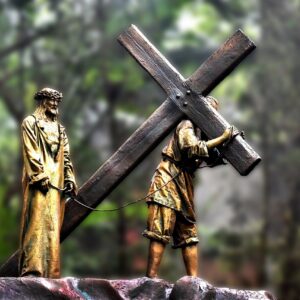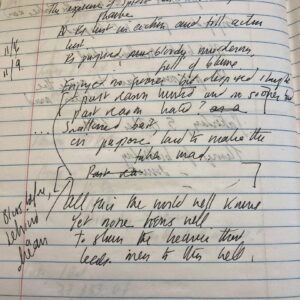Japanese Zen teacher Shunryu Suzuki once famously told his disciples, “Each of you is perfect the way you are…and you can use a little improvement.” In this he expressed a core Soto Zen teaching that practice is already enlightenment. To be fully, freely present “at a station” with no attachment to outcome is already awakening. Robert Duncan’s lyrical “Come, Let Me Free Myself” reflects this basic insight in a rich and original way. (You can hear Duncan reading the poem here.)
Throughout, the poem is characterized by a sense of being mid-way, by double meanings, a certain “both-at-onceness.” Its final line, for instance (“For I stand in the way, my destination stands in the way”), carries both the immediate sense, “I am an obstacle to myself, my attachment to a particular outcome obstructs my path,” and, I would suggest, “I abide and remain in the Way, my own realization (already) abides in the Way.”
The shape and musicality of the lines, the movement through each stanza embodies the gist or argument of the poem, from the lyrical Whitmanic opening through a cramped, uptight second stanza describing a willful enslavement to the superego, to the central situation of the speaker as hitch-hiker at once content and impatient to reach a pre-set artificial goal. The brief fourth stanza spills over from the third and enacts the abrupt, somewhat dull state of impatience it describes, while the fifth and final spreads expansively across the page, returning to the lyrical petition of the first line (“Come, let me free myself from all that I love”) but now releasing the “me” that is magnet and residue of the “comforting chains,” chains the long lines burst through in a twofold culminating insight: “I stand in the way…”
We go toward what we love, it becomes our “destination.” Attachment binds both lover and beloved. The speaker longs to obey not the need and fear that cause him to “bind” what he loves, but to “obey without bound,” in complete responsiveness to life, anchored in the present; in the language of the poem, “at a station…at home / in the sun. Not waiting, but standing here.” The language of “binding” recurs in the last stanza where “I” binds what is loved to “me,” underlining how both the sense of self and the bound object are phantom creations of the act of binding. “Bind” also recalls the poem of Blake (in whom Duncan was steeped and to whom he is often compared):
Eternity He who binds to himself a joy Does the winged life destroy; But he who kisses a joy as it flies Lives in Eternity’s sunrise.
Duncan’s poem seems to work on at least three simultaneous levels. On the literal or narrative plane there is the situation of the speaker hitch-hiking. His physical journey (sketched in so lightly it’s barely there) suggests a spiritual one, but also, I’d say, the poet’s act of composition. As a founding father of the New American Poetry, Duncan would insist that a poem cannot know beforehand where it will end up. To write means to “obey without bound,” without constraining preconception, and to “serve” not fear or desire but only insofar as one “serves” the life of the poem and where it wants to go. Sonically the first stanza dramatizes the aspiration for freedom in the sound of the streaming “ee” breaking out from the road-bump “uh.”
The plea intensifies, “Come, let me be free of this master I set over me” with four “ee” sounds before the German drill sergeant of the superego constrains the stanza into short lines packed with “act, ect, ect, ight, ight.” The shift with “Today,” and the wide open space between stanzas following, feels all the more expansive after standing at attention before this implied inner guard.
In the “today” of the poem the speaker is both “on the road” and “by the road,” both “at home in the sun” and “impatient” to bind the way to himself. “On the road” in the same breath as “hitch-hiking” of course alludes to Kerouac’s novel—with associations of breaking free of all “comforting chains and surroundings” and perhaps to a spontaneous, unfiltered approach to writing that seeks to “obey without bound.” “By the road” perhaps alludes to the W.C. Williams’s poem “Spring and All,” that begins “By the road to the contagious hospital” and describes the subtle emergence of new life in a landscape that seems at first glance still locked in winter. Duncan’s speaker, “on” and “by” the road, is both restless traveler and the landscape he travels through, at once in motion and “standing” (a key word with multiple senses in the Williams poem too), “at home / in the sun,” that is, everywhere, fused with instead of bound to his “surroundings.”
The shortness of the fourth stanza wittily embodies the speaker’s impatience. Unwilling to make way for the way of life, for the poem as it wants to emerge, part of him wants to make it “my way” which seems safer but locks out freedom, just as the attempt to bind love destroys “the winged life.” Simply to remain “at home / in the sun” without expectation or attachment to outcome demands patience, the willingness to suffer, to make way for life. The final stanza recalls the first but with longer, more expansive lines and subtle, telling adjustments:
O let me be free now of my way, for all that I bind to me —and I bind what I love to me, comforting chains and surroundings—
“Me” freeing “myself” has become “let me be free.” The “me” arises as a sense of self that, like the static object of its attachment, is the product of fearful “binding,” trying to lock down with “comforting chains” what’s already passing away. That it’s the chains that provide comfort more than the loved objects is a keen insight. Possession/identification (“my way”) reifies and freezes “all that I love.”
let these loved things go and let me go with them. For I stand in the way, my destination stands in the way.
Expressed as a plea, “let these…go,” the line also states a fact: since the self that craves and the object of craving arise together, when one is let go the other goes with it. As I’ve suggested, these last lines, like numerous other instances of “both-at-onceness” through the poem, can be read in at least two ways. The more natural or immediate meaning seems to be “I am my own worst obstacle, my attachment to a preconceived outcome blocks me from realization. A second sense is that “I can let these loved things go, and let myself go with them because I abide in the Way, I remain, even and especially when I let go of all.” A key part of the poem’s brilliance is the way it linguistically holds together dual meanings in the same line, enfleshing in lyrical, wise, musical language the state of a mind at once perfect just as it is…with room to improve.
Originally from Toronto, Canada, Isaac (John) Slater, a Trappist monk at the Abbey of the Genesee in western NY, is the author most recently of Lean, a chapbook of poems, and Beyond Measure: the Poetics of the Image in Bernard of Clairvaux.





